7-16 Aug 2020
Preamble
Six or seven years into our Australian sojourn I still had a few birds to collect in the south, but lifers close to home were becoming harder and harder to come by. In contrast, the far north still held bags of new birds. In fact even in pre-birding days growing up in Perth I had never been much beyond the Tropic of Capricorn, so there are vast swathes of Australia waiting for me to explore. In both 2018 and 2019 I had tentative plans to go to NT, but those plans were never realised. In 2020, I had a trip to Peru with UK birding mate Steve lined up, but that was cancelled in June because of covid. With very little birding in the first half of the year largely because of lockdown in SA, and my main birding event for the latter part cancelled, I began to wonder if I’d get any birding at all in 2020. But by early July the signs were good that SA, NT, Tas, WA, and maybe Qld had got their covid outbreaks under control and restrictions and border controls started to relax. The date for opening the NT border was set to 23rd July and I hatched a plan for a week of Top End birding in August once the border had opened and flights resumed. Paul Coddington, my traveling/birding companion on various SA twitches and a couple of outback camping trips, had birded NT in 2014 but missed quite a bit of stuff, so he was keen to join me.
We contacted a few tour guides in the hope of paying for a day’s guiding to get some of the more sensitive species like White-throated Grasswren and Red Goshawk. But WTGW turns out to inaccessible even to the guides, and we couldn’t get availability for guiding for the Gos on the days we wanted it. Basically everything else seemed to me to be gettable with enough skill, persistence and some suitably injected local knowledge, so we settled on a fully independent trip. I set about genning up as much as possible, poring over Dolby and Clarke, contacting local birders through social media, and trawling ebird records. Disappointingly, in part because of lockdown, ebird coverage was very patchy.
Paul’s knowledge of the lay of the land from his previous trip was invaluable for sorting out the itinerary, and we based our plans on a combination of what he had done in 2014 and the advertised itineraries of the tour companies. Originally we aimed for Saturday–Sunday (9 days and 8 nights) – but when Qantas cancelled our flight on Saturday we took the option of bringing our start date forward to Friday to give ourselves 10 days and 9 nights, rather than compromise on a 8/7 in which we would likely have to miss out one or more sites/destinations. Our aim would be to spend the first day in Darwin, then head south-east into Kakadu National Park for 3 nights before heading south-west to Pine Creek and Katherine, and then further west into Gregory National Park (Victoria River) towards the WA border, before a dash back up to Darwin for the final night.
TL;DR version is that we had a super-successful trip. In raw numbers we recorded just under 190 species, and I managed 55 lifers and 22 Australian ticks. Apart from the two sensitive species mentioned above, which we didn’t have much hope for, we saw all but one of my lifer targets, and got decent photos of most. As well as our undoubted skill and persistence :-), this is largely down to Paul’s excellent planning and the generous assistance of friends and locals in helping with gen — notably Mike and Steve Potter who gave me various clues during the drive back from a Port Mac pelagic in July, Tom Tarrant who had birded the region just a few weeks before us, Katherine-based birders (and ebirders) Marc Gardner and Mick Jerram, Darwin birders Peter Brown and Peter Kyne, and an unknown Italian-Darwin local who helped us find our main target on Day 1.
Apart from our cancelled flight, which turned into a blessing because of the enforced extra day, all seemed well and our plans were coming together nicely, though we were still struggling for gen on a few key species, notably our #1 target Gouldian Finch, with almost nothing on ebird. Then three days before we were due to leave I got a text from Paul with a link to an article on the ABC news website: yesterday, on the back of 12 cases in Qld, the NT Govt had closed the border with Qld. In SA we had a cluster of about 6 in the western suburbs, and then 2 new cases were added, including one linked to community transmission. The Chief Medical Officer called it a pivotal day in the battle against the virus in SA, and it seemed to both of us that there was now a very high chance that the NT border would be closed, forcing us to cancel. I was in a very bad mood the rest of the day and all night. The next morning I cycled to work through Victoria Park as usual, but was forced to take a detour; a covid testing popup facility had been erected overnight and there were queues of cars across the park and down Wakefield Street. My heart sank further and I arrived at work convinced that the SA/NT border would be closed within hours.
At lunchtime on Wednesday I got another message from Paul, again with a link to an article. I opened it with trepidation, expecting the worst. But in fact it was even better news than I could have hoped. The case that might have been the cause of community transmission turned out to be a false positive. The case numbers in SA for the day were actually adjusted -1 to account for this (and no new cases) and we were in the clear!
Day 1
My taxi failed to show early morning Friday, and I endured an agonising wait for an Uber, finally arriving at the airport at 6.15, a mere 45 minutes before our flight. Fortunately this was still enough time for me check my bags and I even had a few minutes to meet Paul in the Qantas Club (open but with lots of social distancing!) to grab a coffee and some muesli for breakfast. We donned face-masks and boarded for our flight to Darwin!
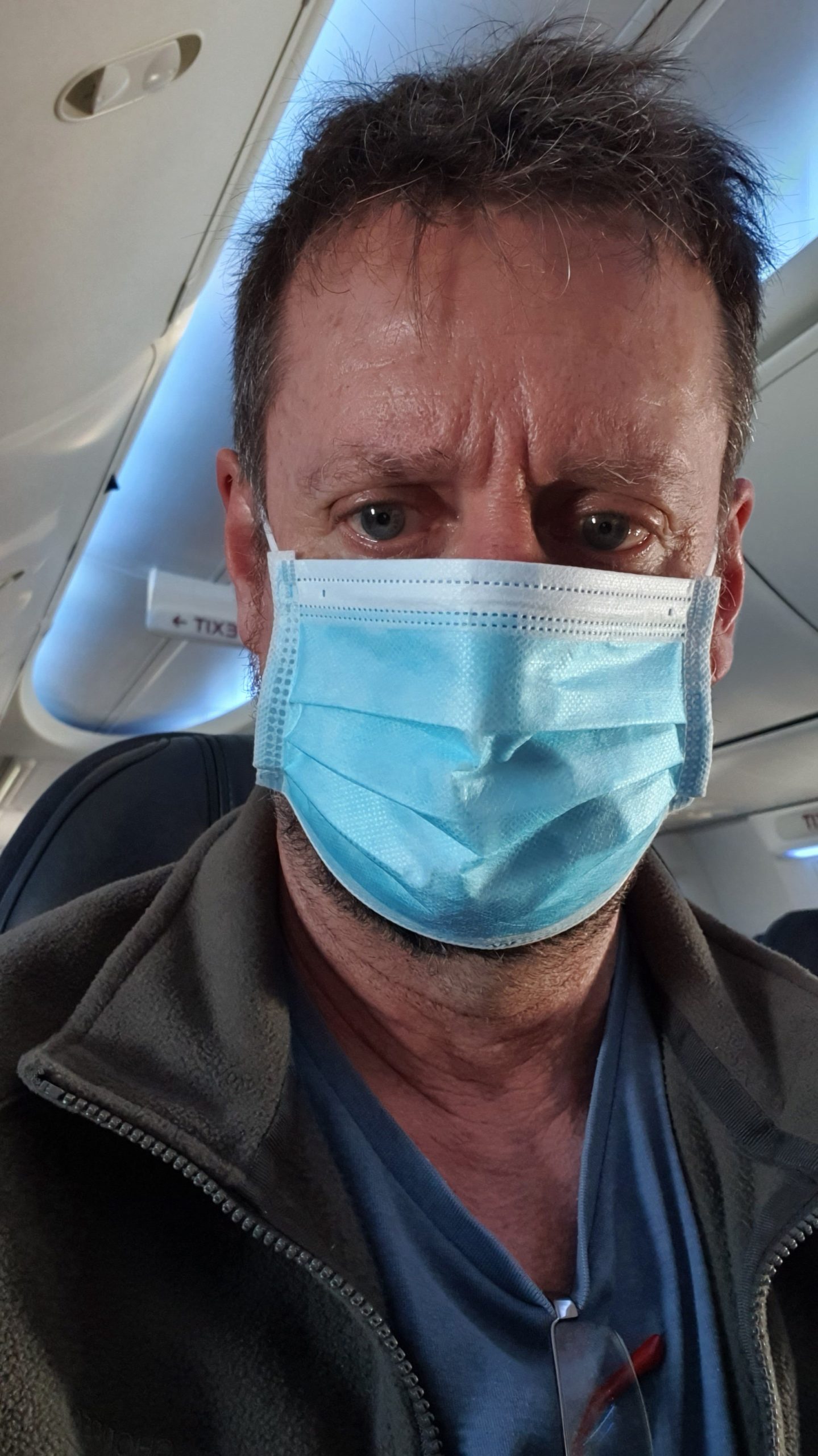
My nose is way too big to be comfortable in a mask 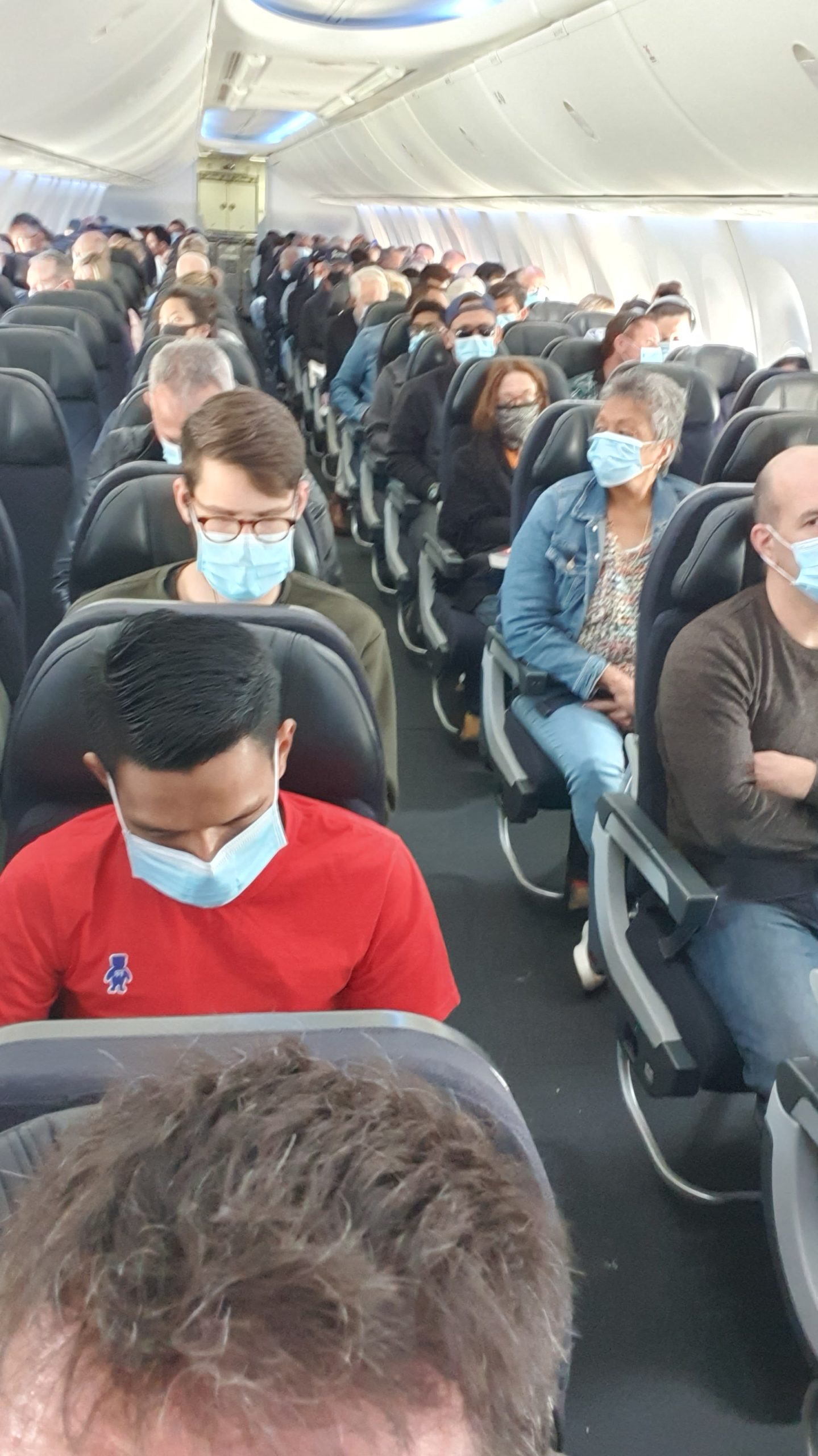
Most people were doing the right thing; masked supplied by Qantas
It’s a bloody long way to Darwin from Adelaide – more than 3 hours’ flight, so it was late morning by the time we had landed in Darwin, cleared the additional covid security, and picked up our Subaru Forester rental (FireFly, but actually Hertz), the only company that seemed to offer unlimited kms). We headed immediately for Lee Point. Midday and low(ish) tide was not a great time to arrive but it still seemed quite birdy and pretty soon I was racking up new birds. Almost instantly we had a Little Bronze-cuckoo and Varied Triller in trees by the beach for my first Australian ticks (I’d seen the former in West Papua two years ago, and the latter in PNG 12 years ago). Bar-shouldered and Peaceful Doves were prominent and would be present at almost every site we visited for the entire trip. In fact a Bar-shouldered called from deep cover sounding for all the world like a Southern Boobook which are quite rare in the north. I was spared public embarrassment at declaring this on ebird by Marc Gardner who pointed out via Messenger that we were hearing BSD! Likewise Orange-footed Scrubfowl were unperturbed by human presence and easily found because they scratch away noisily in the leaf litter.


My first lifer of the trip was a pair of Great Bowerbirds, coming to a slightly leaky drinking fountain in the picnic area. Although they flushed before I could get photos, some patience staking out this spot paid dividends with some Double-barred Finches, Crimson Finches and a Brown Honeyeater. We noted a couple of Forest Kingfisher shuttling around the car-park before we left.
From Lee Point picnic area it is only a few minutes to drive around to the Buffalo Creek boat ramp. A Striated Heron flew past and within a few minutes of arriving we heard the clattering, barking sound of Chestnut Rail, a key target here. But it would not show itself and the rasping call stopped almost as soon as it had started. Passerines were more cooperative and despite the heat, in a short walk around the carpark and to the hide we noted several life-birds for me: White-gaped Honeyeater, Red-headed Honeyeater, Green-backed Gerygone, Large-billed Gerygone, Yellow Oriole, Arafura Fantail, Mangrove Fantail, Northern Fantail, Lemon-bellied Flycatcher, Grey Whistler, Yellow White-eye, Double-barred Finch, Little Friarbird, Helmeted Friarbird, and White-bellied Cuckooshrike. As usually happens when birding in a new area, lifers were coming thick and fast – for me all but the last 4 were completely new – and I failed to get adequate photos of several, something I would later regret.









We grabbed lunch at a Hungry Jack’s then motored a short distance to Osterman St where Marc had sketched a mud-map for us showing a trail out into the mangroves. A small flock of Chestnut-breasted Mannikin and Crimson Finch were in the grass out the back of the suburban houses, several of which had elevated decks that would have afforded a spectacular view across the mangroves to the Timor Sea, especially at sunset! The walk through the mangroves and onto the mudflats is only possible at low tide, and we arrived as the tide was rising, needing to complete our birding within about 90 minutes or risk getting cut off by the rising water.
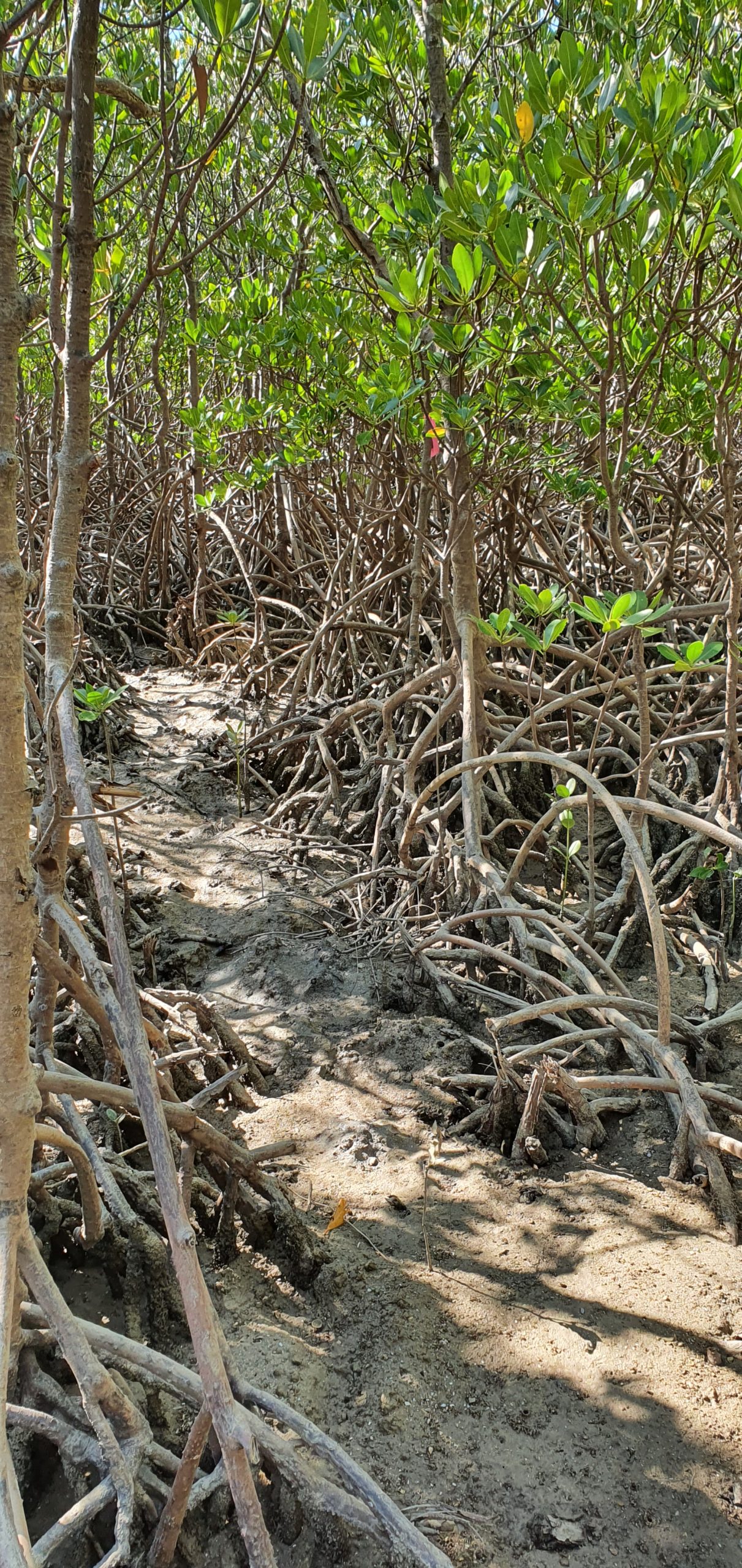
Our walk initially was largely birdless and we retreated somewhat dejected only to bump into local birder Peter Brown who had been on the flats and seen several White-breasted Whistler over the last few hours. He offered to take us back out since he had left his sunglasses and had to go back out anyway. Following his directions we walked on another 100m from where we’d stopped and almost instantly heard a WBW singing, but from a very dense clump of mangroves. As it flushed I got a glimpse of a bird flying low and fast, but totally unidentifiable on that view. We tried another spot but with the tide coming in and one more site to bird this afternoon we knocked it on the head. I harboured thoughts of a return the next day, but Paul wisely counselled that we’d be better off leaving this ‘til our final morning if the tide was right (we checked that evening and yes, it would be).
Next port of call was the George Brown Botanical Gardens. We had only one main target here, though a white bird that flushed low and fast was probably Grey Goshawk, currently nesting in the gardens; I was not on the ball enough at the time and since neither of us needed this pretty raptor we didn’t chase it. In any case I was too fixated on finding our next target, one of my main objectives for the whole week, so we headed directly for the Rainforest Walk where our gen indicated we were most likely to find a Rufous Owl. Although it is a huge bird, scanning rainforest trees for a roosting bird seemed to be a fruitless task, so I was lucky to bump into a friendly local – an ex-pat Italian – who walks the gardens most days. We got chatting and he told about 6 possible roost sites that he was happy to show me. I was losing faith after we visited five and all were empty, but the 6th produced the goods with a stonking – if sleepy – Rufous Owl!


On our way back to the car Paul pointed out another Australian tick for me in the form of Blue-winged Kookaburra and we also noted some Torresian Imperial Pigeons (another Aussie tick).
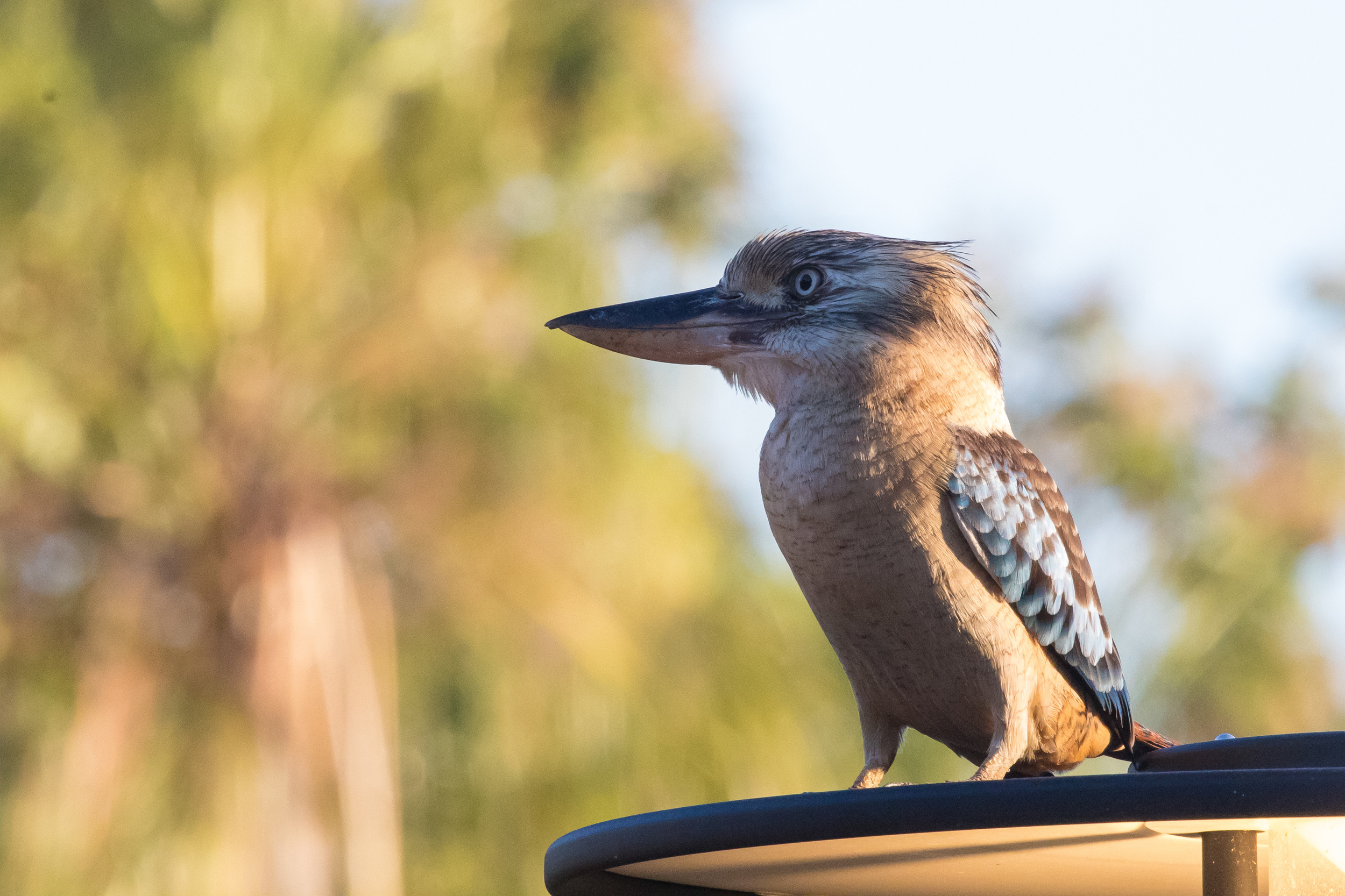
After this we drove the short distance into downtown Darwin, checked into our hotel then drove back out to a spot where there’d been ebird reports of Large-tailed Nightjar at 7pm each evening for the last several days. Soon after the sun went down we heard the characteristic “chop chop” of LTN and I saw two birds, about a minute apart, leave a tall tree in front of the block flats in the cul-de-sac in which we’d parked and swoop over to some rough open ground behind a 6ft fence. A minute or so later a chap arrived to the flats holding a pizza and asked if we’d seen the Nightjars. Unfortunately at this point Paul had not, but on tip-toes I could sweep my wolf-eyes torch across the rough ground and somewhat to my own surprise I was able to pick out some eye shine. A few minutes later we enjoyed the spectacle as it left its perch and hawked elegantly across the field in my torch-light. A lifer for Paul and an Australian tick for me. As we pulled out of the cul-de-sac a message arrived from Marc Gardner:
Marc: “Are you at Guiseppe Crt looking for nightjars by any chance?”.
MeThinks: Hmmm, how can he possibly know that?
Me: “Yes. Just seen a couple :-)”
Marc: “Ah just had a mate Peter Kyne message me saying there’s 2 birders out the front probably looking for nightjars. Can’t move sideways in Darwin lol!”
MeThinks: slowly puts two-and-two together – pizza bearer is Peter Kyne, also reporter of the ebird records we were following!
A meal and a few beers in a pub near our hotel rounded out a great first day.
Day 2
We had designed an itinerary that tried to maximise time finding the birds we both needed, and that meant prioritising the sandstone specialists of Kakadu and finches of the interior. The downside of this was that we would be leaving Darwin by early afternoon today, not to return until our last night. Top target before we left Darwin, therefore, was Chestnut Rail and we worked out the best time to try (on a 4.5m falling tide) was around lunchtime. This meant we could look for a few waders Paul needed at the high-tide roost at Lee Point – about 9am – and have another crack at some of the mangrove specialists before that.
First port of call, then, was the East Point mangrove boardwalk. Sadly this would not be one of our best moves. Others had reported Mangrove Robin, but not only was the walk devoid of mangrove specialists, we saw very little at all. We had encounters with northern specialties White-gaped Honeyeater and Green-backed Gerygone that had been lifers for me the day before, and a nice appearance from a female Shining Flycatcher (Australian tick for me, in fact), but it turns out that the walk gets covered at high tide. As we reached the end of the metal walkway water was lapping at the base, and within minutes was rushing through to wet our boots. As we walked back to the car Black Butcherbird was the sole lifer of this visit for me, though I would not appreciate how similar to Australian Magpie this species is until our final day, when we saw some more. A coffee and muffin at the beachside pop-up café provided some welcome sustenance and lifted the spirits somewhat.
On our way to Lee Point for the waders we also decided to call in at Charles Darwin University which various sources, including Paul’s 2014 visit, suggested could be good for honeyeaters. Disappointingly this was another site that failed to live up to its billing. There were few flowering gums and we noted only a few Little Friarbirds and one addiotonal (unidentified) honeyeater. We also added Osprey to our trip list, but by 9am it was time to move on.
At Lee Point, the rocks that we’d seen yesterday and supposed would be a good high-tide roost were completely covered by the tide, so we cut our losses and trundled around to Buffalo Creek to check out the screen. In fact the screen is a fairly useless bit of infrastructure, too far from the edge of the water for observing the birds and even it weren’t, providing insufficient cover to avoid disturbance. After a quick scan with scope revealed a few sets of waders and terns by the water’s edge some 200-300m away, we crossed the small tidal creek and walked out onto the beach to get better views. Although we remained too distant for decent photos, we connected with the key birds we wanted here, Lesser Sandplover and Lesser Crested Tern, both lifers for Paul and Australian ticks for me. We only found one or two unequivocal Lesser SP amongst dozens of Greater Sandplovers; one was a still sporting some summer plumage and was fairly obviously smaller billed and smaller bodied than the Greater it was next to. The LCTs were easily picked out by their orange bills and slightly smaller size relative to the (Greater) Crested Terns. Several Caspian Tern and a couple of Whiskered Tern were sitting with the mixed flock of Greater and Lesser Crested. Of course there was a good variety of other waders present including Grey-tailed Tattler, Sanderling, Red-necked Stint, Red-capped Plover, Ruddy Turnstone, Great Knot (and a few Red Knot mixed in with mainly Great). Further down the beach were some distant Sooty Oystercatchers.


The day was back on track, but we still had a couple of hours to fill before optimal Rail-viewing time. Mindful that Tom Tarrant had recorded Rainbow Pitta in the mangroves near the hospital, where there is boardwalk down to Casuarina Beach, I pushed for a visit there to “fill in” the time. We hoped this would also give us a shot at Little Kingfisher. Disappointingly a long walk through unattractive savannah and some mangroves down to the beach did not yield either of those targets. A distant Gull-billed Tern was on the beach when we arrived and we spent some time getting to grips with Leaden Flycatcher. On the walk back as we passed some watered gardens at the back of the hospital, I had my first Red-winged Parrot.
We each grabbed a delicious takeaway salad at a food court in Orchard Grove and parked our arses on the boat ramp viewing back up Buffalo Creek. We made sure to be slightly further from the bank than one or two fisherman to ensure they would be first in line for any lurking, hungry crocs. A Brahminy Kite joined one or two Whistling Kites and the numerous Black Kites wheeling overhead, Rainbow Bee-eaters swooped across the creek from overhanging perches, and a couple of Common Sandpipers shuttled back and forth across the water. Just as I finished my lunch that rattling, quite aggressive territorial call of Chestnut Rail barked out across the creek. One burst of playback from me was immediately answered by two birds from the far bank, then another pair from further away, and then two more, seemingly from our side of the creek. I trained my bins on the far side and then a shape started to emerge through the mangroves. I could pick out a pair of Chestnut Rail, keeping largely hidden in the mangroves but moving towards us. Gradually they came closer, calling regularly and also gradually they started to pick their way through the slightly more open areas of mangrove roots by the bank, allowing great viewing, even if they were too far away for totally gripping photos.
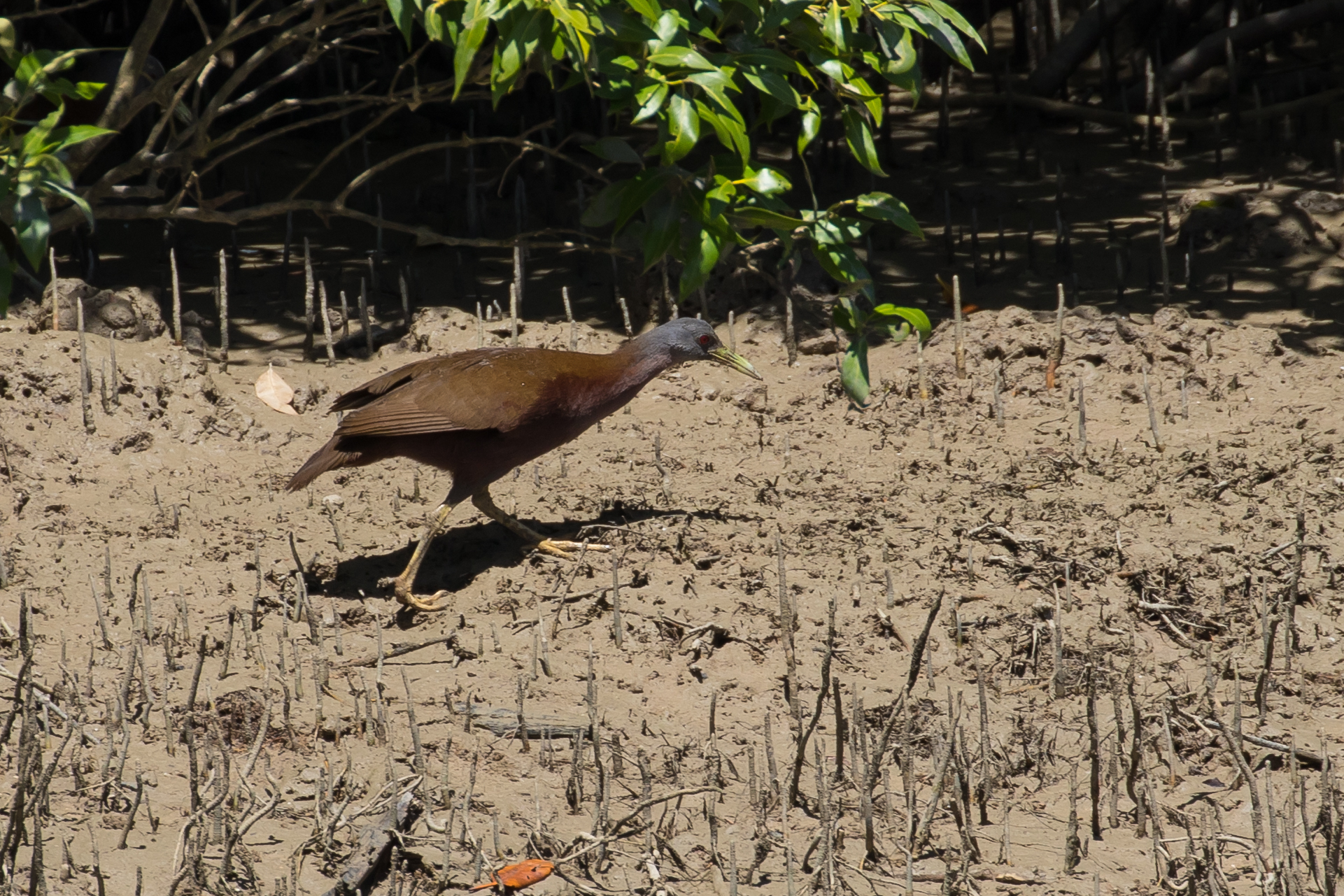
A pair was still calling from very close to us and we decided to move into the mangroves on our side of the creek to see if we could find them too. Indeed I was able to get very close but obscured views of two birds before they became aware of our presence and slipped away through the mangroves much faster than we could follow.
At this point, smarting from yesterday’s dip on White-breasted Whistler and with a favourable tide, I was keen to have another crack in the Osterman St mangroves. Rightly, Paul persuaded me this would jeopardise our time at another key site this afternoon, Fogg Dam, so we bade farewell to Darwin for the time being, headed south on Stuart Hwy then turned off at the marvellously and amusingly named Humpty Doo onto Arnhem Hwy. Just under an hour later we arrived at Fogg Dam, one of the most famous birding sites in/near Darwin. Fogg Dam was built to provide water for a rice project that failed, but within just a couple of years became an important dry-season wetland refuge for wildlife, especially thousands of birds. So by the end of the decade it was a “Bird Protection centre” and was declared a conservation reserve in 1982.
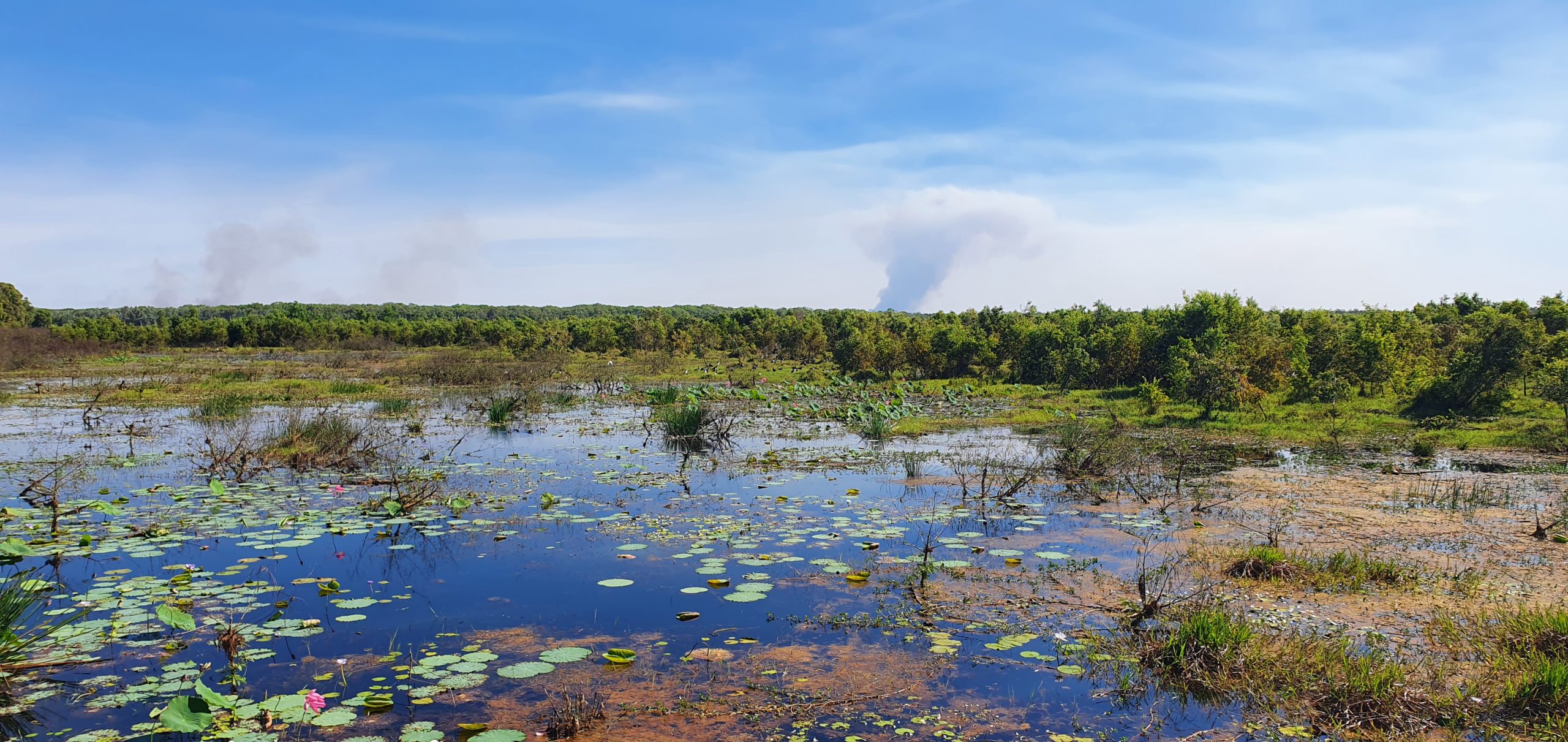
Although it was 14:30 the Woodlands to Waterlily Walk was quite birdy. Immediately we heard Rufous Whistler, found Grey Whistler and even better, an Arafura Shrike-thrush (or the local race of Little Shrike-thrush, depending on your favourite taxonomy). Brown Honeyeaters flitted about teasing us they might be something more special. The path and boardwalk travels through paperbark woodland and monsoon forest to three lake-viewing points. With the lake drying up towards the end of the dry season (following two of the driest wets on record in 18/19 and 19/20) all we could see from the first was dry mud and invasive reedy scrub (my plant knowledge is sadly lacking) that rose up above head height and blocked any view. A couple of Magpie Geese flew past but that was about it.
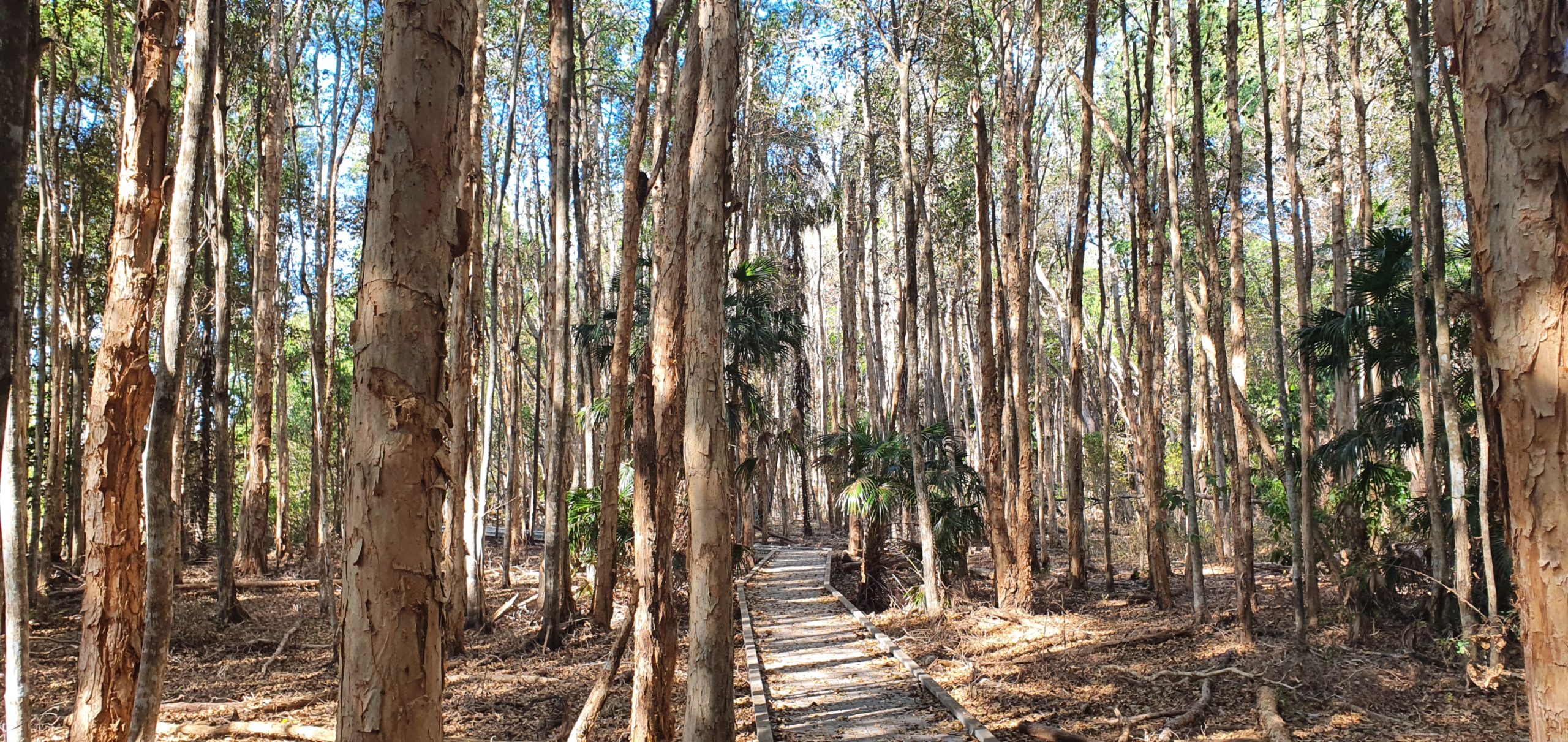
At the next viewing spot, the water was just receding, leaving a few small pools of water and revealing muddy fringes. Dozens of Crimson Finch, mostly juveniles, were drinking and feeding around the edge of the boardwalk. At a small hide we watched several honeyeaters flit about in the reeds and drop down to drink also. It took a while before we could work out what they were – Rufous-banded Honeyeater – because most were juveniles and barely showing their eponymous feature. Eventually we did see an adult with its rufous breast band.



Noises in the reeds made me think of crakes and I played a Spotless Crake call to no response. Paul reminded me we needed to be on the lookout for White-browed Crake, so I played that call as well. Immediately it was answered from three different directions! With patience, eventually we were able to spot movement at the base of the reeds, as the longer we kept still and quiet the bolder it became. Eventually we got decent views (if only record shots) of our second stonking member of the Rallidae today.
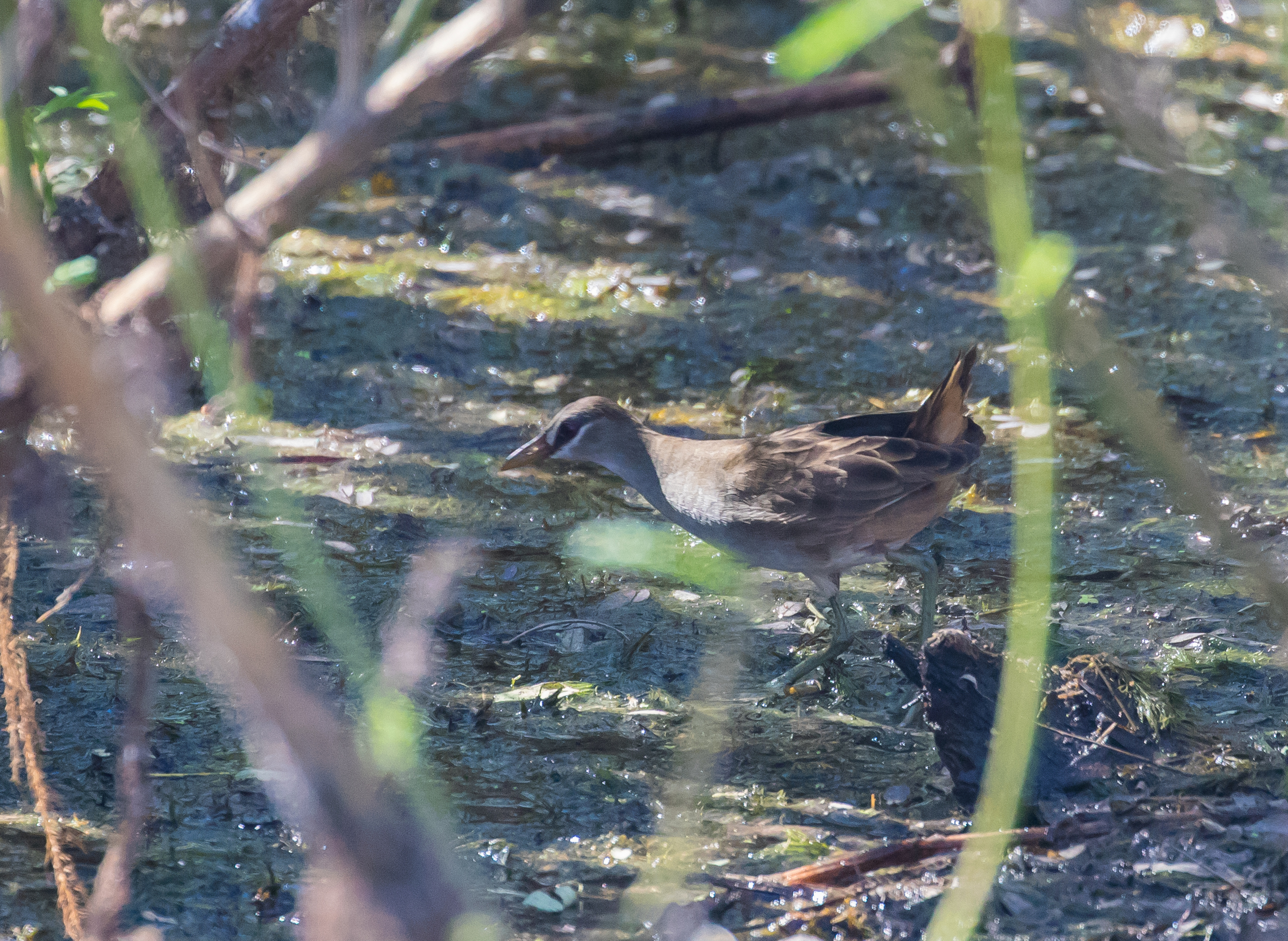
At the end of the boardwalk a platform gives 360 views of the surrounding lake and lilly-pads. Immediately Paul pointed out a small group of Green Pygmy Geese swimming amongst the lillies for my next lifer. Around 50 Magpie Geese were gathered on the shore, and we were able to pick out a few distant Comb-crested Jacana (Australian tick) as well as lifer Pied Heron. This was a distant and slightly unsatisfactory experience for a great looking bird, but with lots of chances to rectify I was not perturbed. We also took the opportunity to sort out Great and Intermediate Egrets. The latter is rare (though semi-regular) in SA and without good views or lots of experience of the respective jizz, can be tricky to separate. Fortunately the close viewing from the platform and boardwalk meant we could definitively note the short gape-line on Intermediate (which stops before the eye) and match this up with other features, notably the shorter, less S-shaped neck.



As we retraced our steps approaching the car we could hear a couple of different low booming calls and worked out these were respectively Torresian Imperial Pigeon and Rose-crowned Fruit-doves, but we saw neither. A few minutes later and a double-whistle – wee-whit, wee-whit – jogged a signal in my brain that got the heart racing: Rainbow Pitta. Paul had not heard it, so we paused and sure enough, somewhat distant but unmistakable, a Pitta called again. We rapidly walked back to where it was coming from, but it stopped calling straight away and did not respond to a short burst of playback.
Back at the car we drove across the dam wall, scanning the shallow and drying lake on one side and the completely dry flood plain on the other. We added Brolga, various common waterbirds including Darter to the list, better, closer views of Comb-crested Jacana, some nice adult Crimson Finch, numerous Masked Lapwing and our first Paperbark Flycatcher (which needs to be read to the tune of Paperback Writer, even if it doesn’t scan properly :-)), which is a split from Restless Flycatcher down south.
At the far end of the wall we scanned from the elevated viewing platform and noted 50 or so Wandering Whistling Duck (lifer) as well as several Radjah Shelduck (Australian tick for me, having only previously seen two on a small island in Raja Ampat). The cattle grazing on the now dry floodplain were a magnet for both Cattle Egret and Brolga.
Late afternoon we arrived at Mary River Wilderness Retreat, our camping spot for the night. We set tents then walked up to the restaurant for very welcome beers and a delicious melt-in-mouth local steak. After a shower and back at the tent a Barking Owl called. It didn’t call again, so although I walked about the campsite a bit and waved my torch around, pretty soon I was ready to turn in. It would be a restless night. Getting used to the heat, and my uncomfortable, inadequate, self-inflating mat was one thing. But in addition, a thirtieth birthday party (which we’d been warned about) ignored the curfew and revellers were still making noise and even honking car horns at 3am. Later, while still dark, very close Bush Stone-curlews called their mournful cry, and then several Blue-winged Kookaburra announced imminent dawn with their aggressive, intrusive laugh.
Day 3
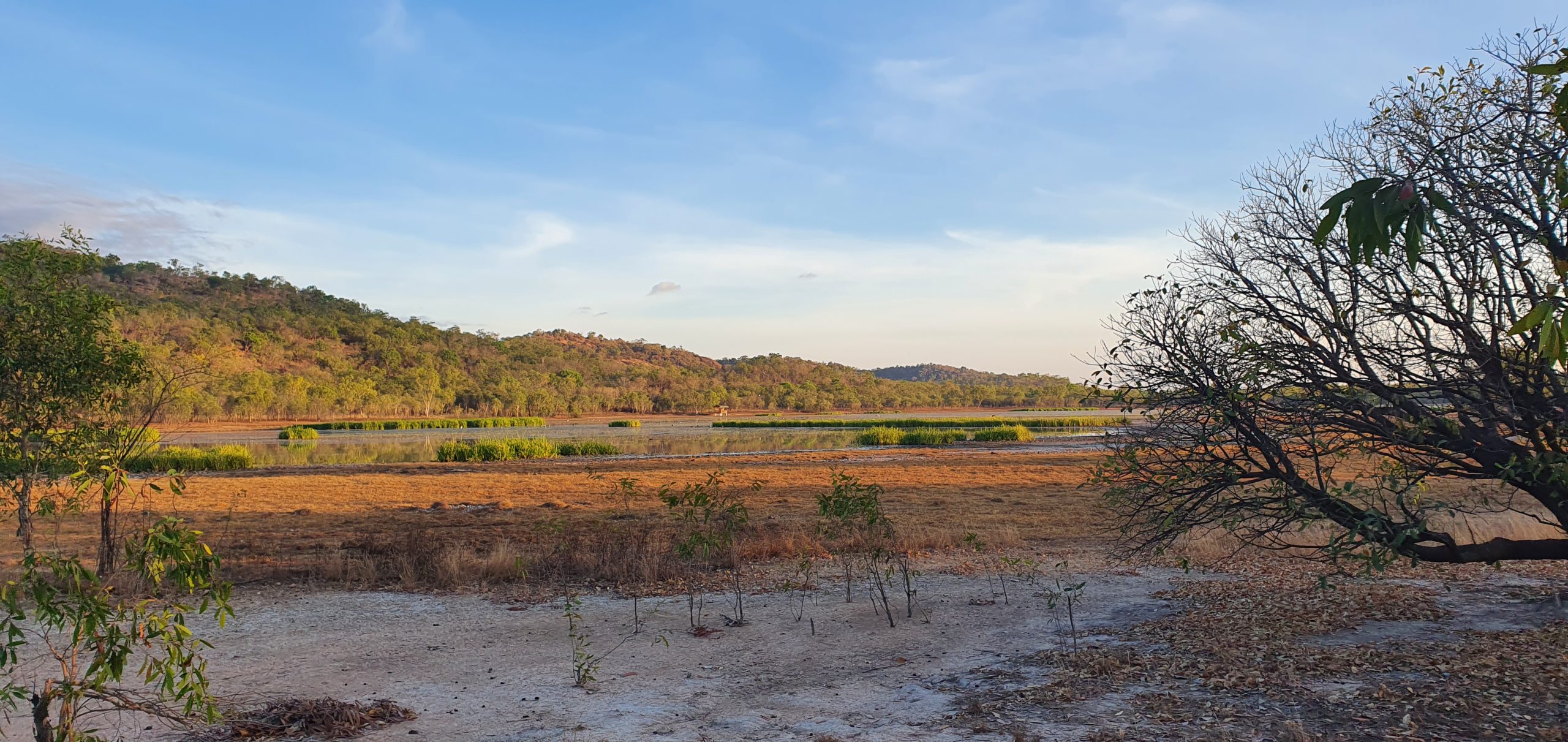
We started the day just a few km from our campsite with a gorgeous walk of 3-4km around the aptly-named Bird Billabong, suitably thronging with bird life as well as Agile Wallabies, and – disappointingly and worryingly – feral pigs. The numbers and diversity were impressive; all 3 Ibis species (White, Straw-necked and Glossy), 4 species of Egret (Little, Intermediate, Great and Cattle)and 3 species of Heron (Pied, White-necked and White-faced). In the beautiful morning light I particularly enjoyed improving on yesterday’s views of the lovely Pied Heron. Hundreds of waterfowl dotted the water: we noted minimum counts of 50 Wandering Whistling Duck, a similar number of Magpie Geese, more than 40 Green Pygmy Geese and 25 Radjah Shelduck, as well as several Pacific Black Duck seeming somewhat out of place as familiar faces in a crowd of newbies.Most of them were very flighty, spooked either us even when we were still quite distant, or by raptors; as well as ubiquitous Whistling Kites we had Swamp Harrier and pair of impressive White-bellied Sea-eagles.







The surrounding savannah woodland was quiet in places, but we also accrued a nice list of woodland birds. Some flyover Lorikeets might have been Varied but were gone before we could get enough on them. Then we tracked down a couple of flycatchers: first Paperbark (cue Beatles harmonies again) then Leaden Flycatcher. A large pair of birds that flew over were big enough for raptors and took some processing by the grey-matter: Channel-billed Cuckoo! We also found Black-faced and White-bellied Cuckoo-shrike, and Varied Trillers were positively common. When we did find a few gums in flower there was quite a bit of activity with several White-throated Honeyeaters, White-gaped Honeyeater and a chance for us to get to grips with Rufous-throated Honeyeater (the juvs of Rufous-throated and Rufous Banded look very similar because neither have their rufous bits yet). A couple of Forest Kingfisher shared the same tree. On the return to the car we noted more feral pigs, as well as a few parrots with a red theme: Red-tailed Black-cockatoo, Red-winged Parrot and Red-collared Lorikeet.
At 9.30 we drove back towards the roadhouse, but pulled over when we saw a couple of birders, Darwin locals on a weekend trip down to Kakadu (I have promptly forgotten their names, but from their accents, both clearly ex-pat poms). It was a good job we stopped for a chat because they turned out to be watching a small flock of Varied Lorikeet. This flock was one of only two or three sightings all week, and our only perched birds!
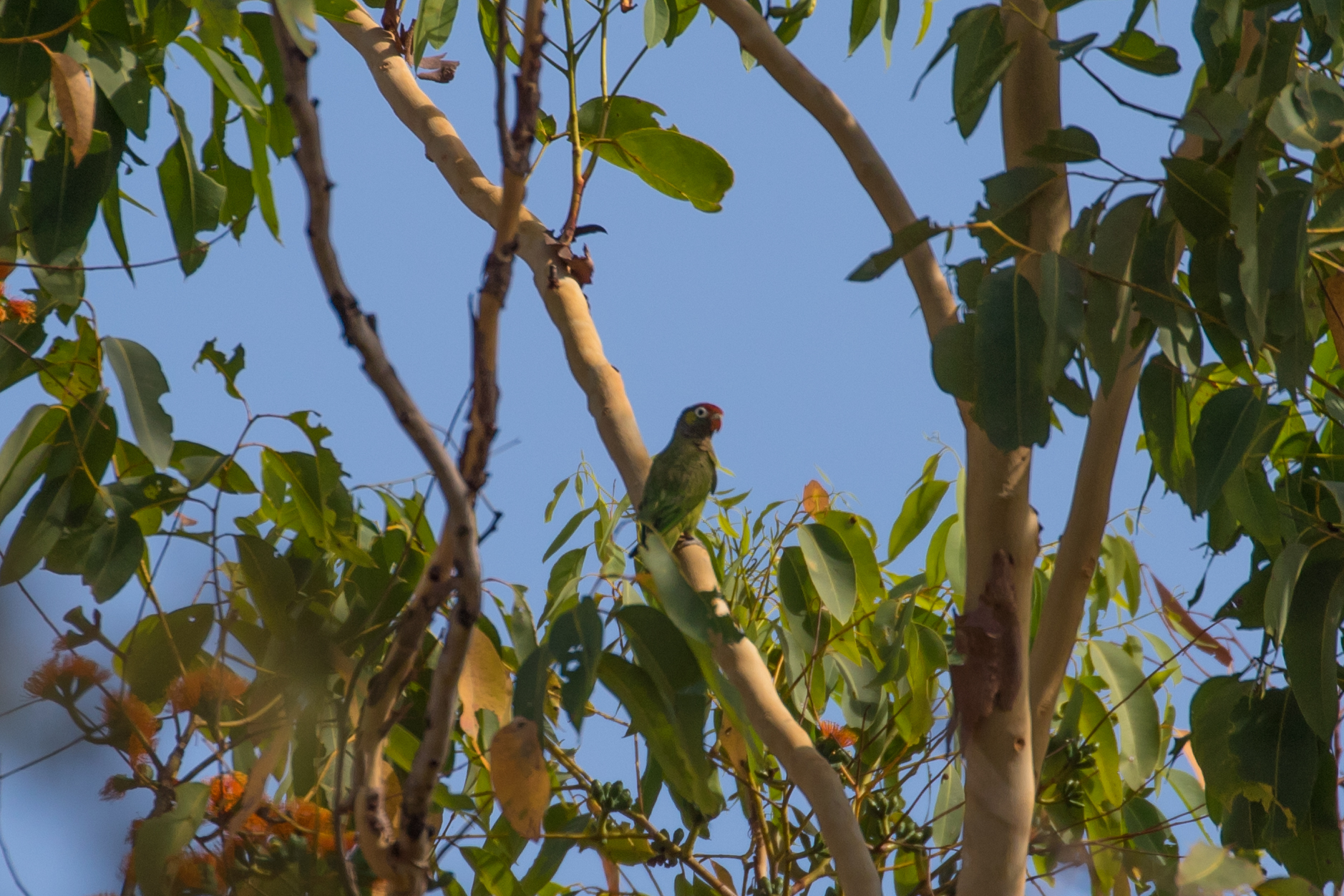
Back at MR Wilderness Retreat we broke camp, grabbed breakfast in the dining room then hit the road for a 90 minute drive to Jabiru in the eastern part of Kakadu. The Arnhem Hwy crosses the South Alligator River en route, and we stopped here for 20 mins or so to stretch legs and check out the area around the boat ramp. A flock of 50 Little Corellas was making a racket, but late morning in 35 degree heat it was otherwise pretty quiet bird-wise. I managed to pull something out of the bag by finding a definitive Broad-billed Flycatcher; we saw two birds and were able to get unequivocal views of the bill-shape and the graduated under-tail feathers. We also noted Lemon-bellied Flycatcher and Paperbark Fly ♫♫ before hitting the road again.
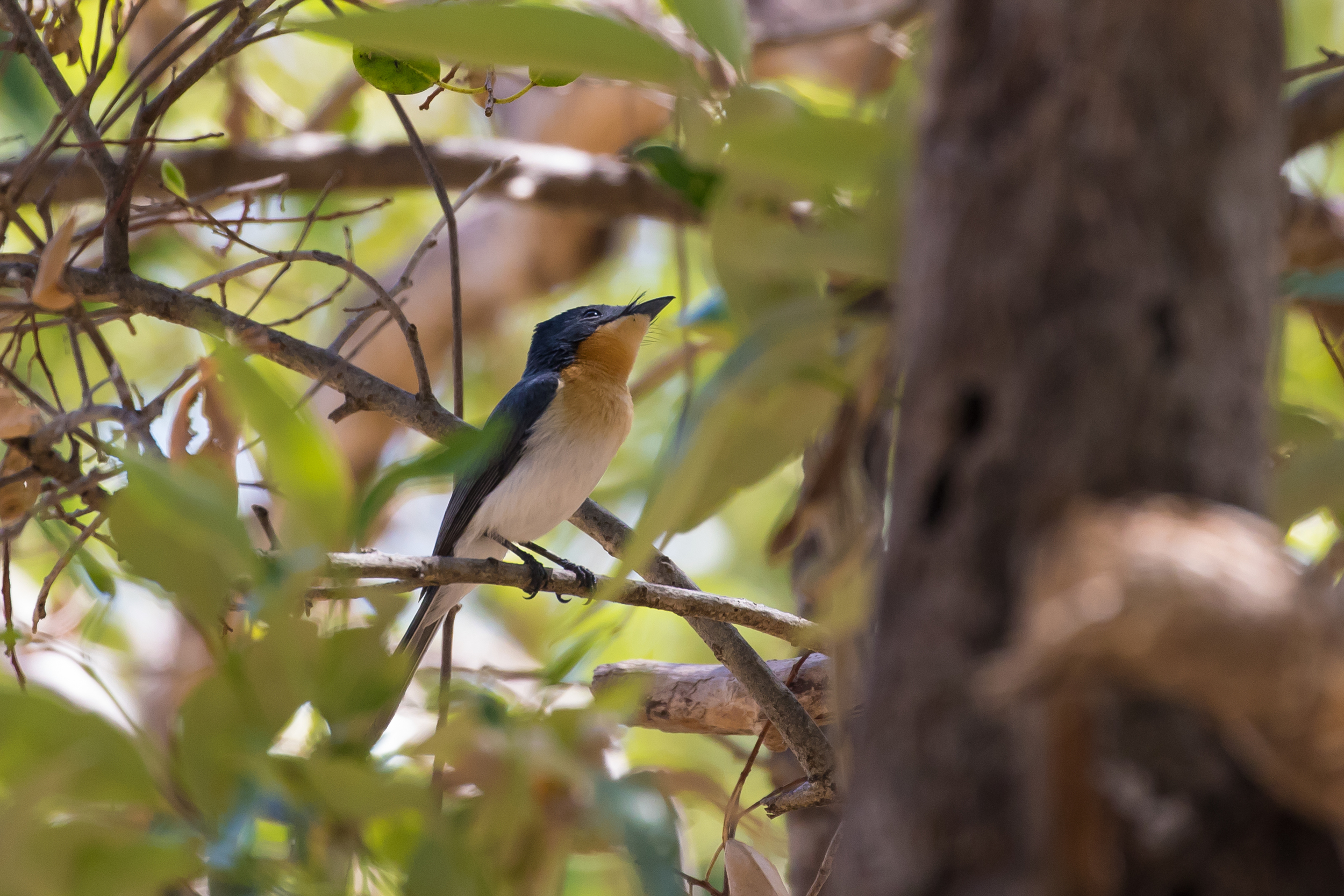
We drove directly to Border Store where we hoped to grab some lunch, but, like many other places, it was closed. This was presumably covid-induced, but there was no indication as to whether it was temporary or permanent. The middle of the day didn’t seem like a particularly good time to be wandering about in the sandstone so Paul suggested we take a walk on the Manngarre Trail in a nearby small monsoon forest. He’d had Rainbow Pitta here in 2014!
At the boat-ramp in the carpark I had my first Saltwater Crocs; a big bastard was lazing on a mud-bank not far from the ramp and another drifted semi-submerged in the tidal current. Although it was a bit cooler in the shade of the monsoon forest, it was largely bird free. About 500m along the trail we’d barely even heard a bird, much less seen any, and Paul suggested I try some pitta playback. I wasn’t too hopeful, but cranked up the app anyway, and to my surprise but excitement, within seconds it had been answered by at least two nearby Rainbow Pittas. They gave us the run-around for at least 20 minutes during which time I was rewarded initially with poor flight views as one bombed across the trail and promptly disappeared again, then various slightly obscured views. Eventually I was sated with my views at least. One of the pictures I did get is shite but quite atmospheric; a bird calling in dappled light making photography rather challenging, but very indicative of the typical pitta experience. Rainbow is my 12th of this iconic family.
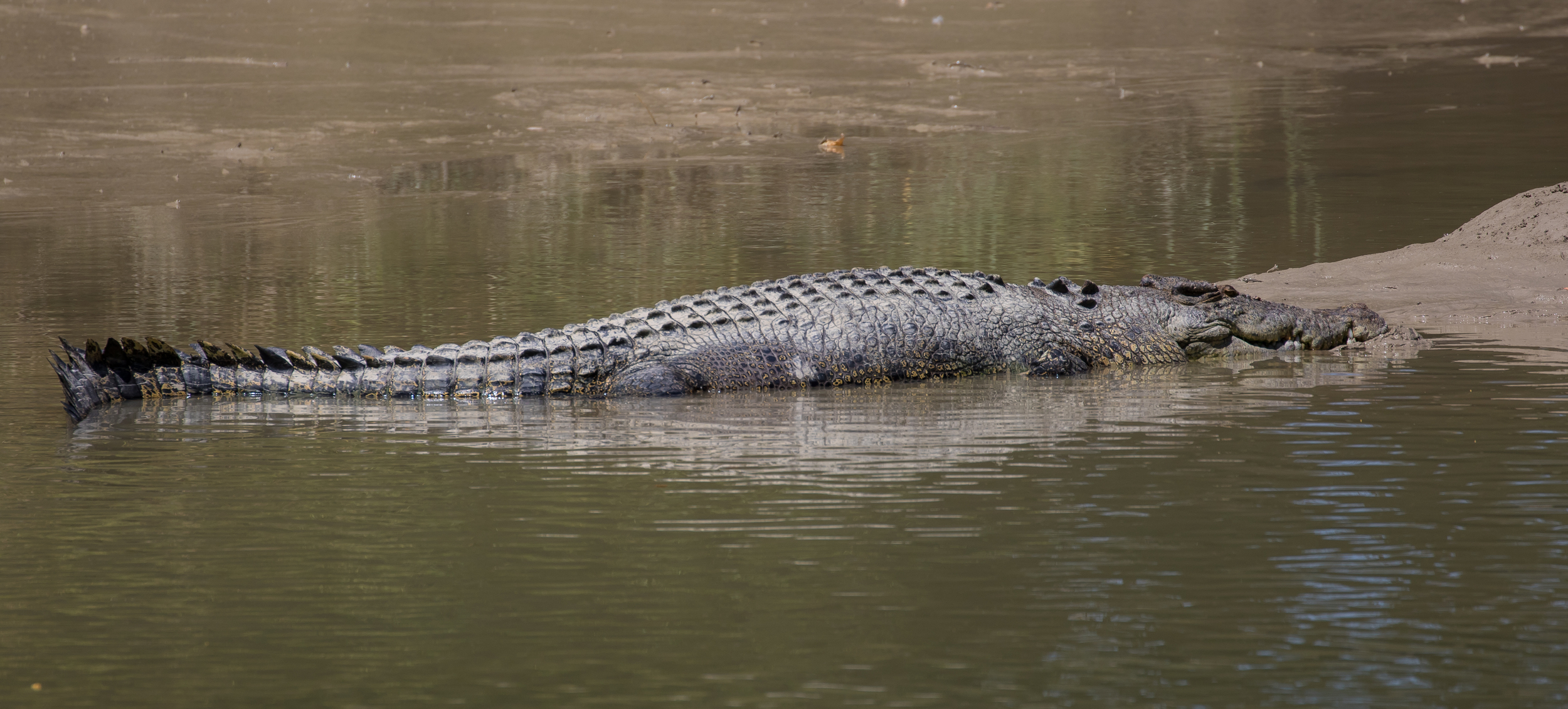
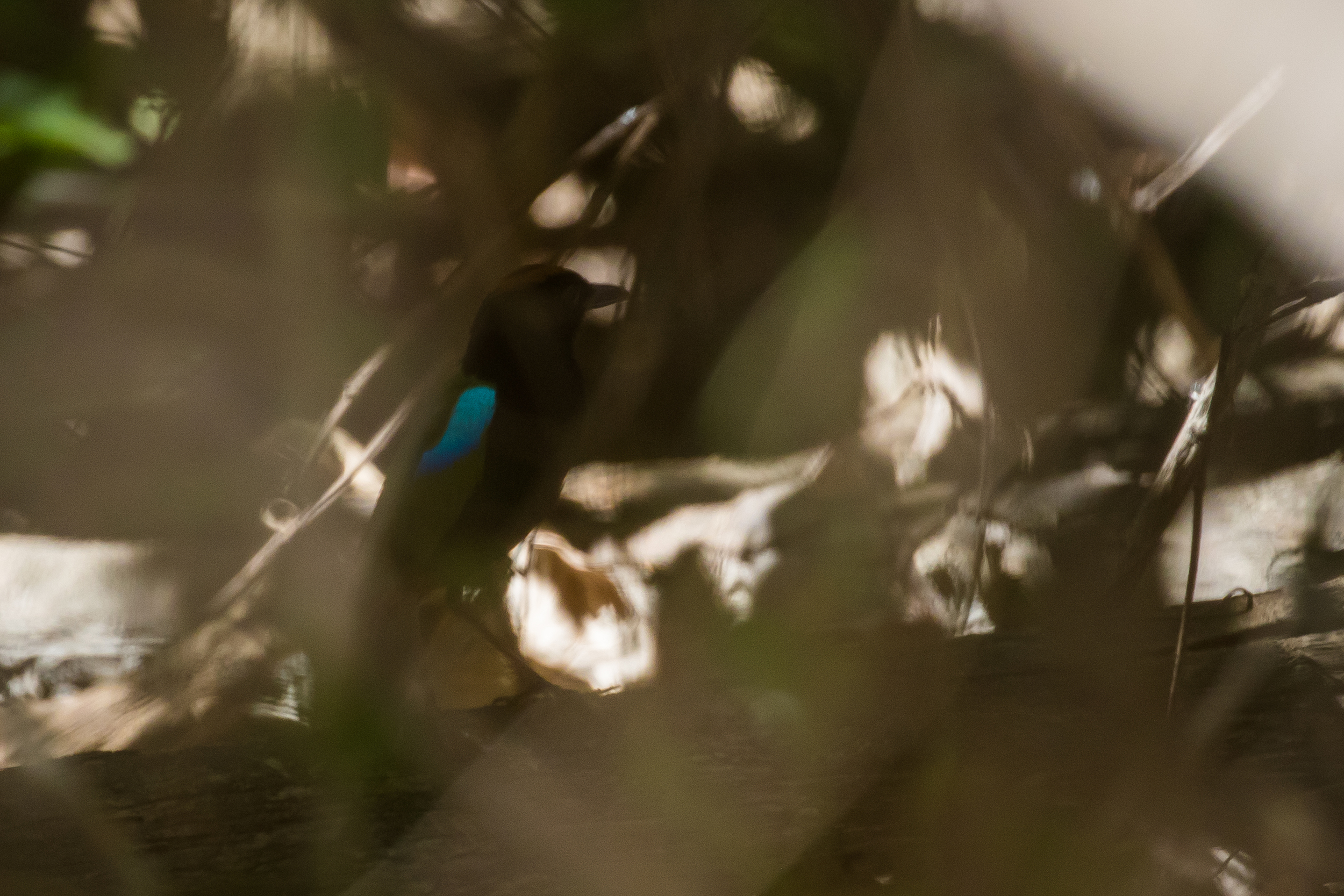
We checked out Cahill’s Crossing, a ford across the East Alligator river into Aboriginal lands, which looked like a real-life version of Frogger – crocs lined up across the river like logs.
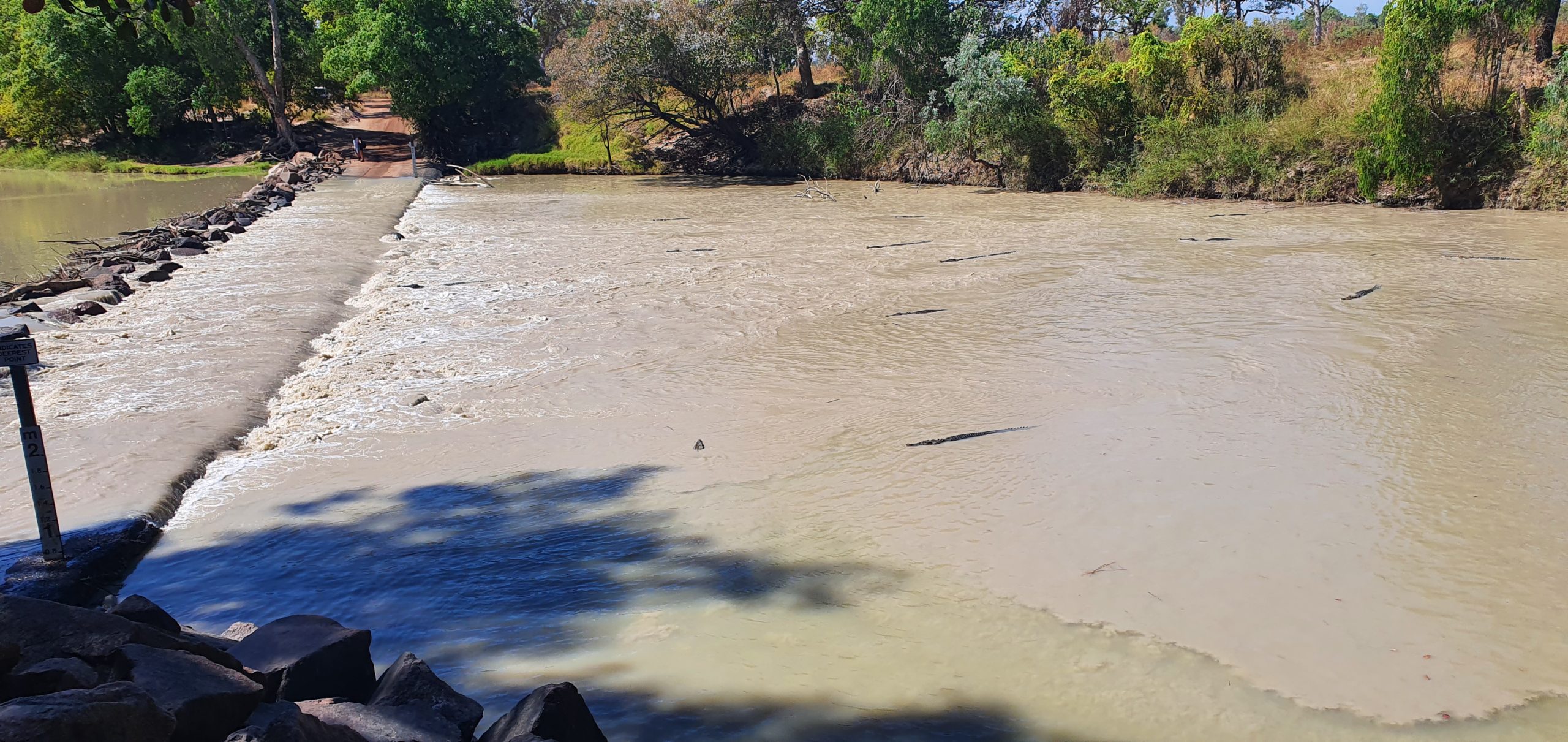
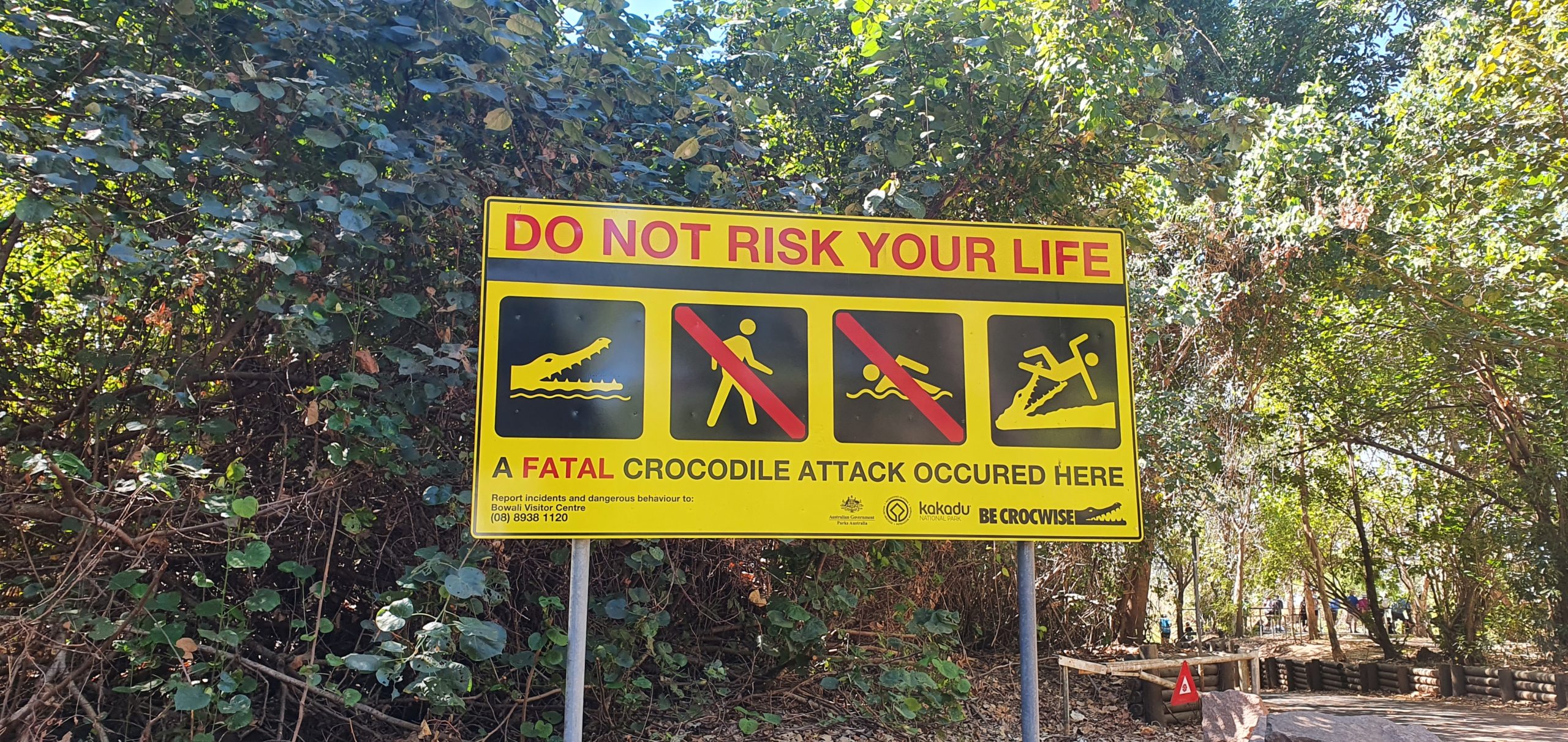
Afterwards we drove a short way to Ubirr, famous for its indigenous rock art and one of the iconic Kakadu sites featured on Crocodile Dundee. We were about to trek off to the rock art but I’d left something in the car. As I walked back to unlock, I vaguely recognised a soft cooing. I looked up and there were four Chestnut-quilled Rock-pigeons on the large rock directly above our car!


The view across the East Alligator river flood plain is spectacular, and very famous for sunsets (we were too early), but a stunning pair of soaring Black-breasted Buzzards completed the experience for us.
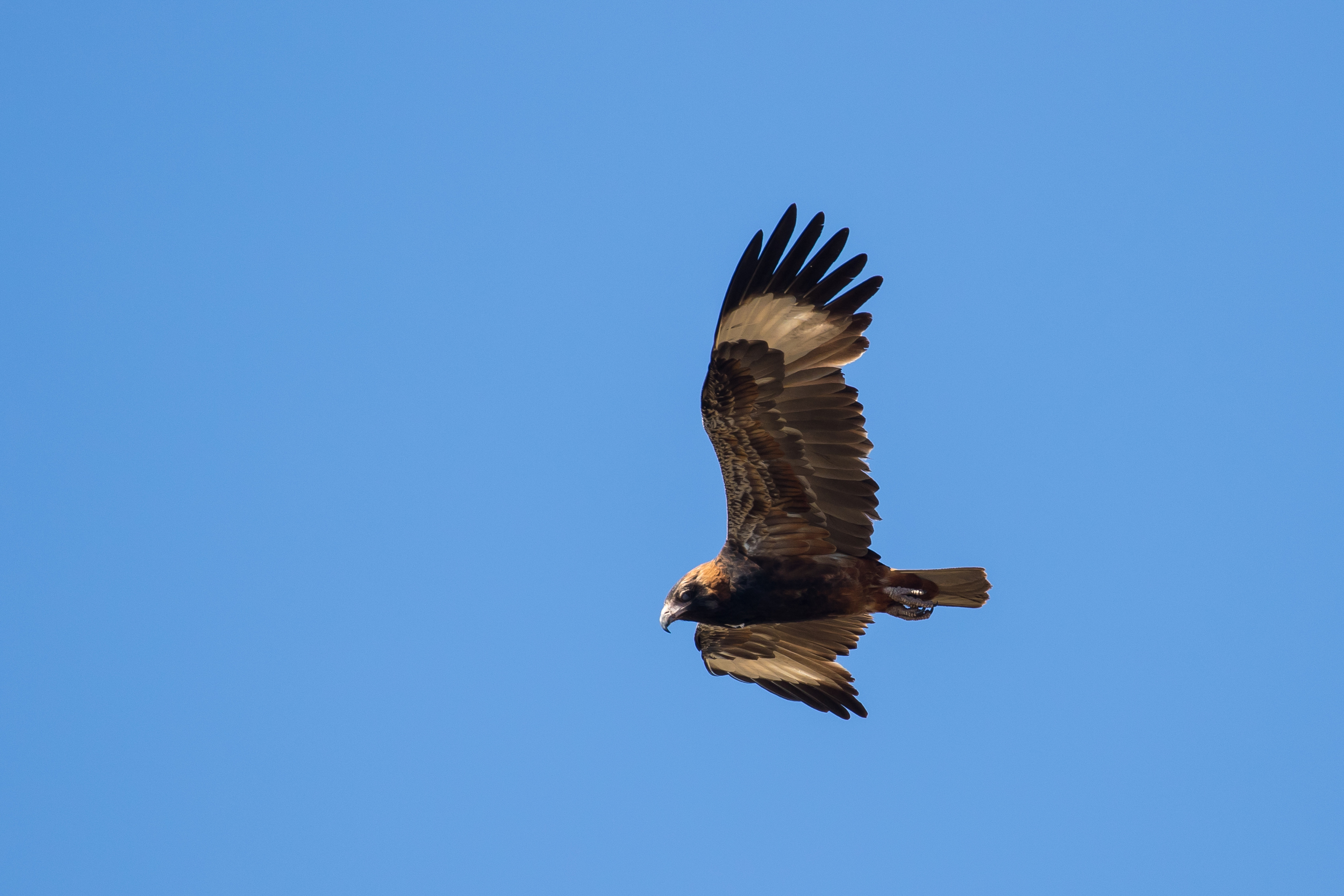

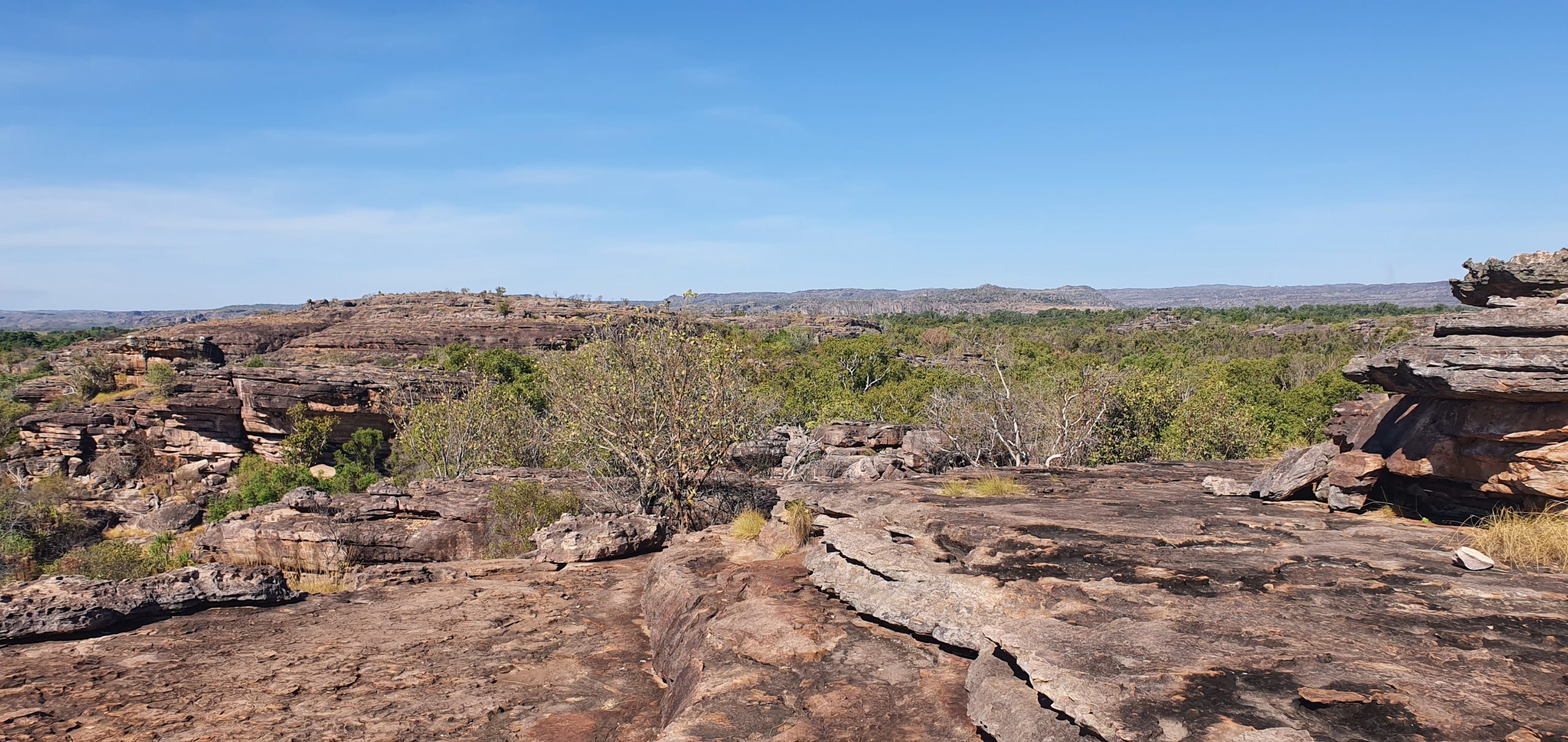



On the road back towards Jabiru I spied something on the far verge and braked hard, swinging car around so we could view back along the road through the side windows. I was glad I did stop, because this turned out to be our only Partridge Pigeon of the week!


An hour later we arrived at Cooinda where we had a choice of campsites. Probably quieter, and certainly less busy, would have been the Mardugal Campground. However mindful of the joys of beer after birding I opted for the slightly more upmarket, and definitely much busier, Cooinda Lodge Caravan Park. Initially I regretted this but after I faffed quite a bit and we’d found a quieter bit of the unpowered section we set tents and assessed whether we had time for more birding. On this occasion, our judgement that we did was somewhat amiss; we drove 25 minutes back to Nourlanngie Rock (it was further than we remembered, but we did see a young Dingo by the roadside), arriving just before sunset. The 10 minute walk we had at the base of the rock was birdless and felt like a waste of a trip, especially because we were both fretting at the ominous “Open 9am-Sunset” sign by a gate across the road; we would not want to be locked in here miles from nowhere overnight. Fortunately our worries were misplaced, because the gate was open as we drove out with the light fading. Back at the lodge we showered then walked over to the bistro for dinner, and of course those beers.
On the way back to the tent a Bush Stone-curlew ran in front of us by the ablution block, and I would hear also Barking Owls before falling asleep. Despite the busy camp-ground, tonight the noises were wildlife and not human.
To be continued…

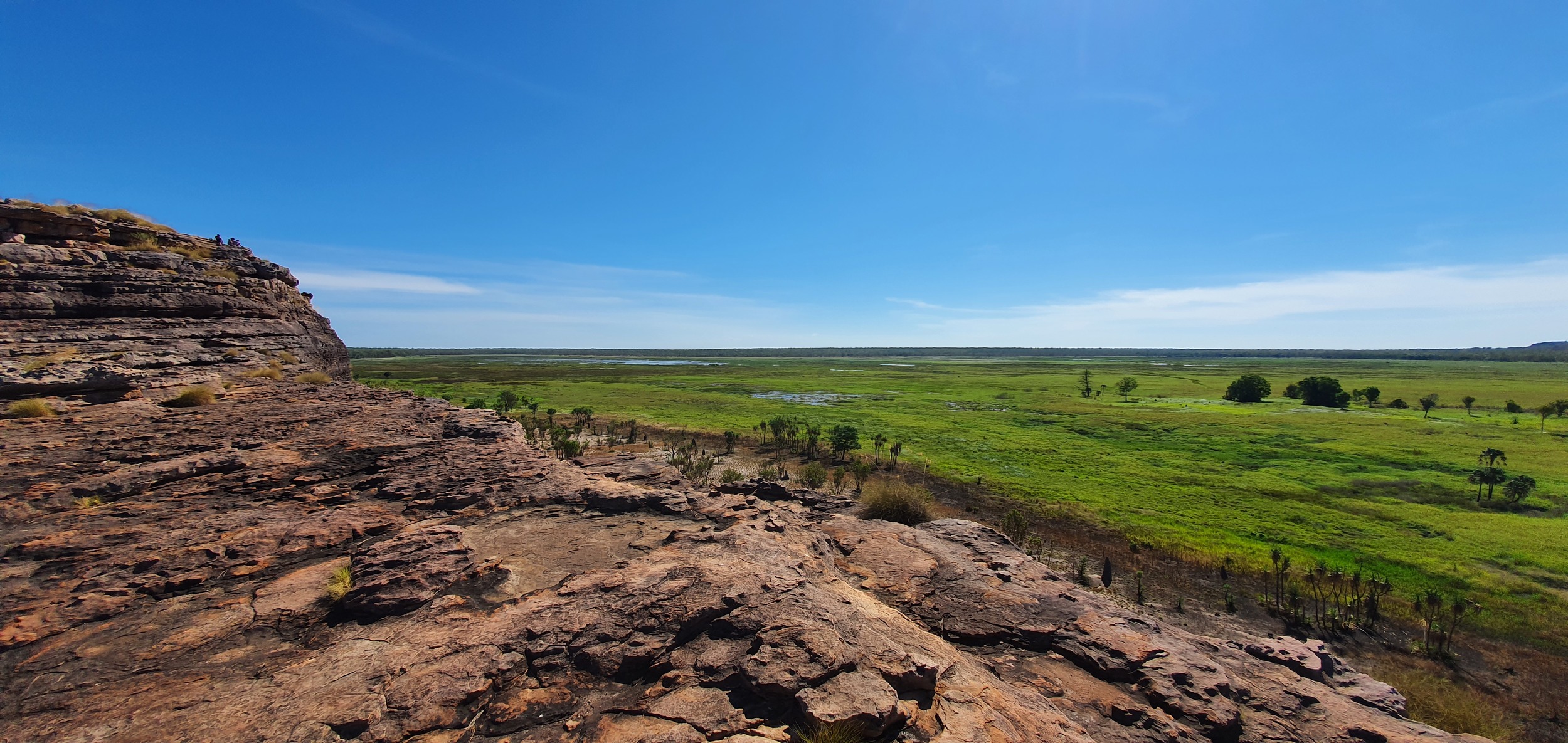
2 Comments
Comments are closed.